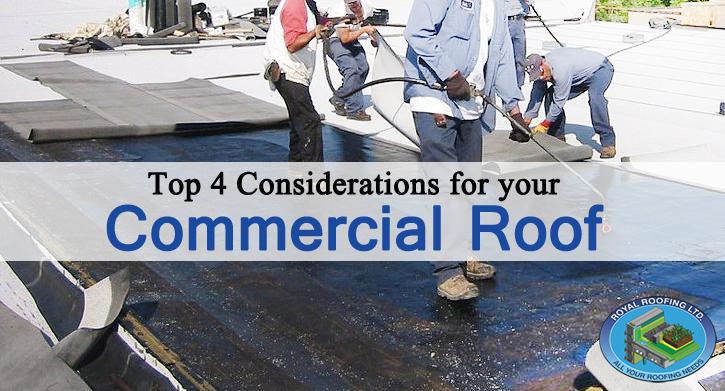Top 4 Considerations for your Commercial Roof
Oct 29,2016

As the owner or director of a commercial property, you know the requirement for arranging and planning for maintenance repairs and overhauls so that each expenditure brings the best ROI. Finding out about the key contrasts amongst commercial roof and residential roofs can help you comprehend why it's vital to employ a roofing contractor with the abilities and experience to maintain your roof so as to avoid any unnecessary inconvenience and expense.
Extraordinary Aspects of a Commercial Roof
You may imagine that a roof is a roof, yet most commercial roofs vary drastically from residential roofs in several ways:
Design:
Although some commercial structures have pitched roofs like a home, most are "flat," with a low incline. Most commercial roofs have significantly more square footage than a residential roof, and have particular design considerations like an implicit drainage system and the extra strength expected to support the additional weight of ventilation and warming/cooling equipment.
Materials:
A portion of the materials generally used on residential roofs like metal boards and black-top shingles are also used on slanted commercial roofs. Just by its design, a flat "low incline" commercial roof perseveres thanks to more straightforward integration of the components and climate but is more defenseless against leaks, so the materials used to cover it must be immensely tough and appropriate for larger areas. That is the reason most low incline roofs are secured with membrane materials like built-up roofing, single-ply and modified bitumen.
Installation:
With regards to low-incline commercial roofs, a roofer needs expertise and ability working with the material they're installing. Moreover, a commercial roofer needs to comprehend the special difficulties of making flat roofed buildings water tight, such as welding creases properly, introducing flashing effectively, working around blocks and parapets, and guaranteeing satisfactory drainage to avoid the problems related to standing water causing "ponding" and potential structural failure. A commercial roofer additionally needs the larger teams and modern, specialized equipment that are important to introduce a membrane roof in a timely and effective manner.
Maintenance:
Low-incline commercial roofs create distinctive issues not typically found with residential roofs. For example; ponding water, crease partitions, membrane punctures, shrinkage and splitting, flashing decay around penetrations and clogged drains. Thus, the low-incline or flat roof on a commercial building requires regular checks and maintenance so developing issues are managed quickly.
Get in touch with us today at Royal Roofing Ltd. for developing up a viable plan to keep your commercial roof in good shape for years to come.


